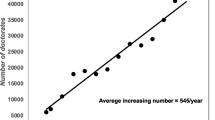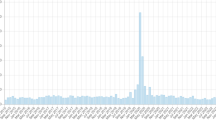Abstract
The “Biglan model,” a classification system arraying academic fields and disciplines into eight cells, is frequently cited and has become a generally accepted new eponym in the field of higher education. Bibliographic indicators and co-citation patterns document that John Smart (and associates) introduced the eponym to the field, but he is never expressly acknowledged for the contribution. Over time, the eponym may be taking on new, more theoretical, meaning. As this eponym becomes further diffused throughout the literature, there are signs that citations to the Smart messenger may diminish, along with obliteration of the formal citation of Biglan. The disappearance of citations is not atypical, nor is it a violation of normal scholarly practices but, in fact, it undermines the veracity of typical bibliometric studies of intellectual influence structures.
Similar content being viewed by others
References
Barnes, M. W., Creswell, J. W., and Patterson, R. A. (1986). Correlates of scholarly recognition in the field of higher education.Review of Higher Education 9(2): 159–175.
Bayer, A. E. (1983). Multi-method strategies for defining “core” higher education journals.Review of Higher Education 6(2): 103–113.
Bayer, A. E., and Jahoda, G. (1979). Background characteristics of industrial and academic users and nonusers of online bibliographic services.Online Review 3(1): 95–105.
Bayer, A. E., and Jahoda, G. (1981). Effects of online bibliographic searching on scientists' information style.Online Review 5(4): 323–333.
Bayer, A. E., Smart, J. C., and McLaughlin, G. W. (1984). Mapping intellectual structures of a scientific subfield through author co-citations. Paper presented at the annual meeting of The Society for Social Studies of Science, Ghent, Belgium.
Biglan, A. (1973a). The characteristics of subject matter in different academic areas.Journal of Applied Psychology 57(3): 195–203.
Biglan, A. (1973b). Relationships between subject matter characteristics and the structure and output of university departments.Journal of Applied Psychology 57(3): 204–213.
Braxton, J. M., and Nordvall, R. C. (1985). Selective liberal arts colleges: higher quality as well as higher prestige?Journal of Higher Education 56(5): 538–554.
Brown, R. E., et al. (1986). Stress on campus: an interactional perspective.Research in Higher Education 24(1): 97–112.
Chubin, D. E., and Moitra, S. D. (1975). Content analysis of references: adjunct or alternative to citation counting?Social Studies of Science 5: 423–441.
Creswell, J. W., and Bean, J. P. (1981). Research output, socialization, and the Biglan model.Research in Higher Education 15(1): 69–91.
Drees, L. A. (1982). The Biglan model: an augmentation. Unpublished Ph.D. dissertation, University of Nebraska.
Eison, C. L. (1976). The measurement of job satisfaction and departmental association at Western Kentucky University: testing the Holland and Biglan models. Unpublished Ed.D. dissertation, University of Kentucky.
Fiedler, F. E., and Gillo, M. W. (1974). Correlates of performance in community colleges.Journal of Higher Education 45(9): 672–681.
Garfield, E. (1979).Citation Indexing: Its Theory and Application in Science, Technology, and Humanities. New York: Wiley.
Garfield, E. (1983). What's in a name? the eponymic route to immortality.Current Contents: Social and Behavioral Sciences 14(47): 384–395.
Hayward, P. C. (1986). A discriminant analytic test of Biglan's theoretical distinction between biology and English department chairpersons. Paper presented at the annual meeting of the Association for the Study of Higher Education, San Antonio.
Kay, H. E. M. (1973). In praise of eponyms.Lancet 2: 1256.
Kaplan, N. (1965). The norms of citation behavior: prolegomena to the footnote.American Documentation 16: 179–184.
Lawani, S. M., and Bayer, A. E. (1983). Validity of citation criteria for assessing the influence of scientific publications: new evidence with peer assessment.Journal of the American Society for Information Science 34(1): 59–66.
Medawar, P. B. (1979).Advice to a Young Scientist. New York: Harper & Row.
Merton, R. K. (1965).On the Shoulders of Giants: A Shandean Postscript. New York: Free Press.
Merton, R. K. (1973).The Sociology of Science: Theoretical and Empirical Investigations. Chicago: University of Chicago Press.
Moravcsik, M. J., and Murugesan, P. (1975). Some results on the function and quality of citations.Social Studies of Science 5: 86–92.
Oromaner, M. (1985). The Ortega hypothesis and influential articles in American sociology.Scientometrics 7: 3–10.
Ortega y Gasset, J. (1960).The Revolt of the Masses (second ed.) New York: Norton.
Ravetz, J. R. (1971).Scientific Knowledge and its Social Problems. Oxford: Clarendon.
Roskens, R. W. (1983). Implications of the Biglan model research for the process of faculty advancement.Research in Higher Education 18(3): 285–297.
Schoenhofer, S. O. (1983). An analysis of managerial philosophies held by department chairpersons in Biglan model clusters. Unpublished Ph.D. dissertation, Kansas State University.
Small, H. (1973). Co-citation in the scientific literature: a new measure of the relationship between two documents.Journal of the American Society for Information Science 24: 265–269.
Small, H., and Griffith, B. C. (1974). The structure of scientific literatures: Identifying and graphing specialties.Science Studies 4: 17–40.
Smart, J. C., and Elton, C. F. (1975). Goal orientations of academic departments: a test of Biglan's model.Journal of Applied Psychology 60(5): 580–588.
Smart, J. C., and Elton, C. F. (1982). Validation of the Biglan model.Research in Higher Education 17(3): 213–229.
Smart, J. C., and McLaughlin, G. W. (1978). Reward structures of academic disciplines.Research in Higher Education 8(1): 39–55.
White, H. D., and Griffith, B. C. (1981). Author cocitation: a literature measure of intellectual structure.Journal of the American Society for Information Science 32: 16–22.
Author information
Authors and Affiliations
Rights and permissions
About this article
Cite this article
Bayer, A.E. The “Biglan model” and the smart messenger: A case study of eponym diffusion. Res High Educ 26, 212–223 (1987). https://doi.org/10.1007/BF00992030
Received:
Issue Date:
DOI: https://doi.org/10.1007/BF00992030




